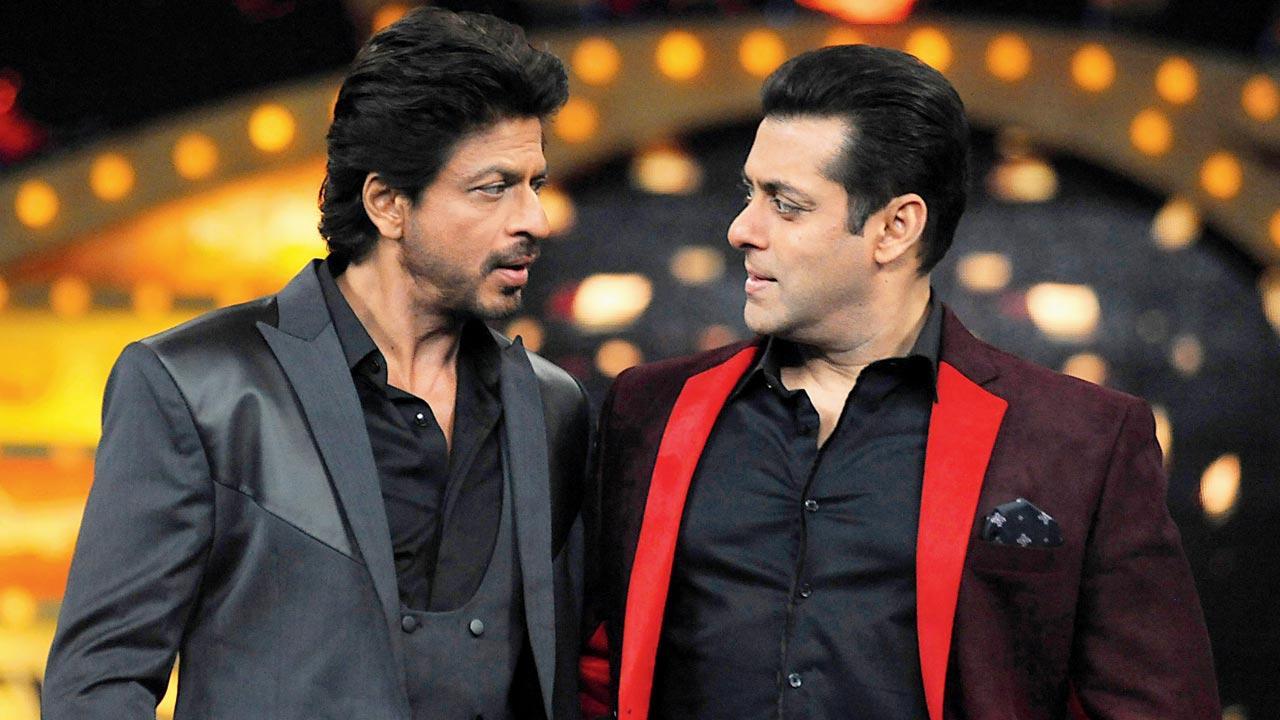Author Kaveri Bamzai’s new book explores the political, economic and social circumstances in which three talented young men, with a shared surname, rose to startling fame

Shah Rukh Khan and Salman Khan had a brief fallout in 2008 at party hosted by Katrina Kaif. At the core of the fight was a proposal by Salman that the three Khans, who were seated at one table at the party, writes Bamzai. Pics/Getty Images
In 1988, when Aamir Khan made his massive “re-entry” into the Hindi film industry with the teen romance Qayamat Se Qayamat Tak, India was in the throes of a new order. “On the economic front, controls over electronic and computer imports were relaxed. A new education policy was being drafted. On the political front… the promise of the initial Rajiv Gandhi years had gone down the tubes with the Shah Bano case, the bungling over the Punjab Accord, the aborted Defamation Act [that made an attempt to muzzle the press] and worse, the allegations of kickbacks for recommending the Bofors gun to the Indian Army,” writes author and independent journalist Kaveree Bamzai in her just-released book, The Three Khans: And The Emergence of New India (Westland Non-fiction). Somewhere else Salman Khan, 23, had made his debut as Vicky in the film, Biwi Ho To Aisi, while Shah Rukh Khan, another 23-year-old, had people swooning over his deep dimples as Captain Abhimanyu Rai in the Doordarshan serial Fauji.
ADVERTISEMENT
It almost appears serendipitous that three men of the same age, carrying the weight of a shared surname, in a changing India, where communal intolerance was simmering, even if slowly, were steering a grand entry for themselves in Bollywood, around the very same time. Bamzai says she found it remarkable that the troika, which began their careers together, are still going strong over three decades later.
Aamir Khan
Yet so much has changed, she admits in an email interview. “The India of 1988 was on the cusp of the three great forces of market, Mandal and Mandir and these three men through their movies helped us negotiate the changes in our social fabric. As they aged, their personalities evolved, their opinions were refined, and their voices, all too often, silenced. Each decade in a way has been coterminous with the rise of one Khan—if the ’90s were the decade of Shah Rukh Khan romancing the great Indian family and its values, the 2000s were when Aamir Khan discovered a new, more organised form of storytelling, and the 2010s were when Salman Khan went from no-hoper to beloved action hero. It was fascinating to me how the Khans changed as India did and how they interacted with each other, spurring each other to achieve more, be more,” explains Bamzai, on why she wrote the book.
The author, who has met each of the Khans, interviewing them at different points in their careers, says she started taking keen interest in them, somewhere in 2010, when Salman’s reinvention with Dabbang “showed the possibilities of stardom”. “Here was a Khan whom many had written off, but suddenly he was able to capture the zeitgeist of a nation tired of Swiss-based romances and looking for its glossy equivalent in the small towns of India, authentic but in a synthetic, kitschy cool way,” she says.
Kaveree Bamzai
Seeped in nostalgia, Bamzai’s book turns back the clock to the early 1990s, when the script for economic liberalisation of India was first written, and how it impacted the Hindi film industry, in particular the Khans. Subsequent events, the communal riots, terror attacks, the mafia’s influence, which ran into the early millennium, and the growing nationalism, would also shape their brand of cinema. If Dilip Kumar, Raj Kapoor and Dev Anand embodied Nehruvian Socialism, the Khans, says Bamzai, represented the values of a “liberalised India, which tried to ride the tide of social engineering, but failed”. “Through their movies, the Khans helped us negotiate tradition and modernity, redefined the Indian family in India and abroad, and tried to reshape our understanding of masculinity, rural-urban mobility and movements against hidebound ideas in education, women empowerment and blind faith,” she says. She, however, feels that their predominance in the cultural landscape did not mean more harmony, more communal understanding and more love. “As they rose, they carried within them their own seeds of destruction, embodying precisely the old ways of doing business—nepotism, yes, but also a sense of nationhood, which repeatedly celebrated diversity, whether it was in Lagaan’s fictional cricket team or in Chak De! India’s hockey team or Bajrangi Bhaijaan’s cross-border kiddie drop.”
It was but the General Election of 2014 and the rise of Narendra Modi that would pit them against an unlikely superstar. “It brought to power a storyteller, who would rival the Khans in reach, direct connect and in sophisticated messaging,” says Bamzai.
The writer also trains the lens on the personal lives of these actors, their controversial and often rocky affairs, their tumultuous marriages and friendship, and most importantly their relationship with each other, sometimes unpredictably calm and friendly, and at other times, volatile enough to court controversy. Their lives are inter-connected, she feels. “They [the Khans] are always looking over their shoulder, conscious of what the other is doing, without really admitting to the world that the other person is their competition,” says Bamzai, adding, that if not for their presence in each other’s lives, things would have not been the same. She believes that their story will always be linked with that of modern Indian history. “[They will be remembered as] three men, who were once young, just as India was; who grew up with India; who made mistakes, celebrated their successes, and tried again after falling, just like India did.”
 Subscribe today by clicking the link and stay updated with the latest news!" Click here!
Subscribe today by clicking the link and stay updated with the latest news!" Click here!






